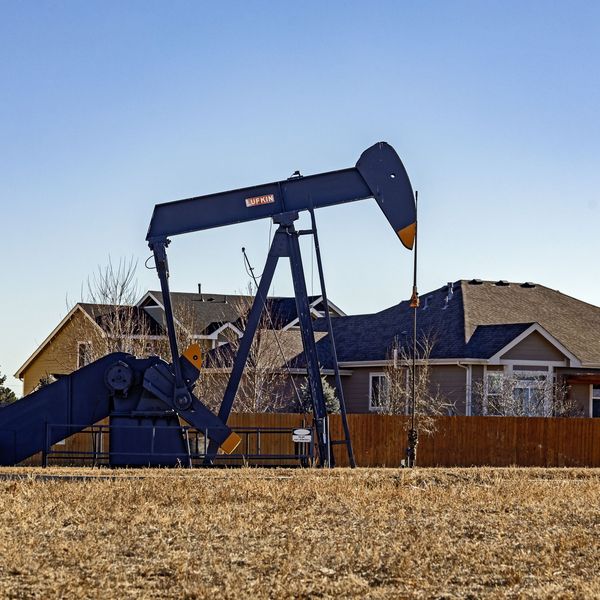Bombshell Study Reveals Methane Emissions Hugely Underestimated
Findings throw EPA emissions database and countless other fracking studies into question
The amount of methane being leaked from natural gas production sites has been hugely underestimated, according to a "bombshell" new study released on Tuesday.
In a paper published at Energy & Science Engineering, expert and gas industry consultant Touche Howard argues that a much-heralded 2013 study by the University of Texas relied on a faulty measurement instrument, the Bacharach Hi-Flow Sampler (BHFS), causing its findings to low-ball actual emission rates "by factors of three to five."
"The data reported by the University of Texas study suggest their measurements exhibit this sensor failure, as shown by the paucity of high-emitting observations when the wellhead gas composition was less than 91% CH4, where sensor failures are most likely," Howard writes, "during follow-up testing, the BHFS used in that study indeed exhibited sensor failure consistent with under-reporting of these high emitters."
Jamie Henn, communications director for 350.org called Howard's findings a "bombshell," adding: "The more we learn about fracking, the worse it is for the environment."
If Howard is correct, the study throws into question countless other estimates of methane emissions from natural gas production through hydraulic fracturing, or fracking, which has been hailed as a low-emission energy solution.
Since 2003, natural gas companies have often shared BHFS recordings with the Environmental Protection Agency to help compile a national greenhouse gas inventory.
"If Howard's right, we'll need to review other emission estimates used in EPA inventories," Robert Jackson, an earth science professor at Stanford University who studies methane leaks, told Inside Climate News. "We need to sort this out as quickly as possible."
The study comes just a day after President Barack Obama unveiled his new climate plan, which calls for an increase in natural gas production to balance cuts in carbon emissions. However, scientists have long warned that methane is potentially even more destructive that other fossil fuel emissions. According to the Environmental Defense Fund, in the first two decades after its release, methane is 84 times more potent than carbon dioxide.
The backpack-sized BHFS has two sensors: one for measuring low level methane emissions and one for higher levels as the gas rises. According to Howard, who happens to hold the patent for some of the technology used in the Bacharach product, unless the sampler is carefully and frequently recalibrated, the switchover from the first sensor to the second can fail, causing an under reporting of total emissions.
Further, Howard notes that without independent measurement at the time of the malfunction, "there is no way to determine the magnitude" of the error. Therefore, the missed emissions could be as high as ten- to a hundredfold for a particularly large leak, he said.
An Urgent Message From Our Co-Founder
Dear Common Dreams reader, The U.S. is on a fast track to authoritarianism like nothing I've ever seen. Meanwhile, corporate news outlets are utterly capitulating to Trump, twisting their coverage to avoid drawing his ire while lining up to stuff cash in his pockets. That's why I believe that Common Dreams is doing the best and most consequential reporting that we've ever done. Our small but mighty team is a progressive reporting powerhouse, covering the news every day that the corporate media never will. Our mission has always been simple: To inform. To inspire. And to ignite change for the common good. Now here's the key piece that I want all our readers to understand: None of this would be possible without your financial support. That's not just some fundraising cliche. It's the absolute and literal truth. We don't accept corporate advertising and never will. We don't have a paywall because we don't think people should be blocked from critical news based on their ability to pay. Everything we do is funded by the donations of readers like you. Will you donate now to help power the nonprofit, independent reporting of Common Dreams? Thank you for being a vital member of our community. Together, we can keep independent journalism alive when it’s needed most. - Craig Brown, Co-founder |
The amount of methane being leaked from natural gas production sites has been hugely underestimated, according to a "bombshell" new study released on Tuesday.
In a paper published at Energy & Science Engineering, expert and gas industry consultant Touche Howard argues that a much-heralded 2013 study by the University of Texas relied on a faulty measurement instrument, the Bacharach Hi-Flow Sampler (BHFS), causing its findings to low-ball actual emission rates "by factors of three to five."
"The data reported by the University of Texas study suggest their measurements exhibit this sensor failure, as shown by the paucity of high-emitting observations when the wellhead gas composition was less than 91% CH4, where sensor failures are most likely," Howard writes, "during follow-up testing, the BHFS used in that study indeed exhibited sensor failure consistent with under-reporting of these high emitters."
Jamie Henn, communications director for 350.org called Howard's findings a "bombshell," adding: "The more we learn about fracking, the worse it is for the environment."
If Howard is correct, the study throws into question countless other estimates of methane emissions from natural gas production through hydraulic fracturing, or fracking, which has been hailed as a low-emission energy solution.
Since 2003, natural gas companies have often shared BHFS recordings with the Environmental Protection Agency to help compile a national greenhouse gas inventory.
"If Howard's right, we'll need to review other emission estimates used in EPA inventories," Robert Jackson, an earth science professor at Stanford University who studies methane leaks, told Inside Climate News. "We need to sort this out as quickly as possible."
The study comes just a day after President Barack Obama unveiled his new climate plan, which calls for an increase in natural gas production to balance cuts in carbon emissions. However, scientists have long warned that methane is potentially even more destructive that other fossil fuel emissions. According to the Environmental Defense Fund, in the first two decades after its release, methane is 84 times more potent than carbon dioxide.
The backpack-sized BHFS has two sensors: one for measuring low level methane emissions and one for higher levels as the gas rises. According to Howard, who happens to hold the patent for some of the technology used in the Bacharach product, unless the sampler is carefully and frequently recalibrated, the switchover from the first sensor to the second can fail, causing an under reporting of total emissions.
Further, Howard notes that without independent measurement at the time of the malfunction, "there is no way to determine the magnitude" of the error. Therefore, the missed emissions could be as high as ten- to a hundredfold for a particularly large leak, he said.
The amount of methane being leaked from natural gas production sites has been hugely underestimated, according to a "bombshell" new study released on Tuesday.
In a paper published at Energy & Science Engineering, expert and gas industry consultant Touche Howard argues that a much-heralded 2013 study by the University of Texas relied on a faulty measurement instrument, the Bacharach Hi-Flow Sampler (BHFS), causing its findings to low-ball actual emission rates "by factors of three to five."
"The data reported by the University of Texas study suggest their measurements exhibit this sensor failure, as shown by the paucity of high-emitting observations when the wellhead gas composition was less than 91% CH4, where sensor failures are most likely," Howard writes, "during follow-up testing, the BHFS used in that study indeed exhibited sensor failure consistent with under-reporting of these high emitters."
Jamie Henn, communications director for 350.org called Howard's findings a "bombshell," adding: "The more we learn about fracking, the worse it is for the environment."
If Howard is correct, the study throws into question countless other estimates of methane emissions from natural gas production through hydraulic fracturing, or fracking, which has been hailed as a low-emission energy solution.
Since 2003, natural gas companies have often shared BHFS recordings with the Environmental Protection Agency to help compile a national greenhouse gas inventory.
"If Howard's right, we'll need to review other emission estimates used in EPA inventories," Robert Jackson, an earth science professor at Stanford University who studies methane leaks, told Inside Climate News. "We need to sort this out as quickly as possible."
The study comes just a day after President Barack Obama unveiled his new climate plan, which calls for an increase in natural gas production to balance cuts in carbon emissions. However, scientists have long warned that methane is potentially even more destructive that other fossil fuel emissions. According to the Environmental Defense Fund, in the first two decades after its release, methane is 84 times more potent than carbon dioxide.
The backpack-sized BHFS has two sensors: one for measuring low level methane emissions and one for higher levels as the gas rises. According to Howard, who happens to hold the patent for some of the technology used in the Bacharach product, unless the sampler is carefully and frequently recalibrated, the switchover from the first sensor to the second can fail, causing an under reporting of total emissions.
Further, Howard notes that without independent measurement at the time of the malfunction, "there is no way to determine the magnitude" of the error. Therefore, the missed emissions could be as high as ten- to a hundredfold for a particularly large leak, he said.

